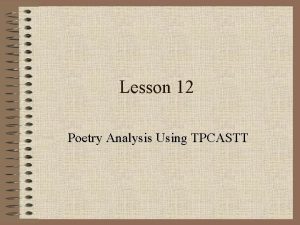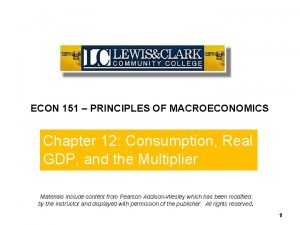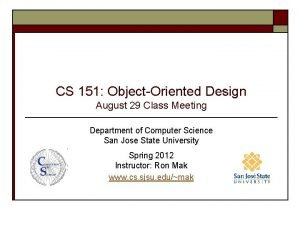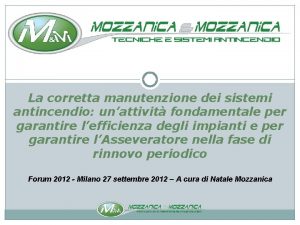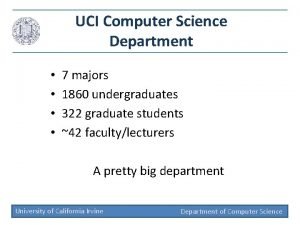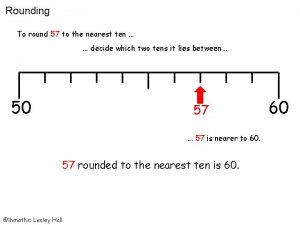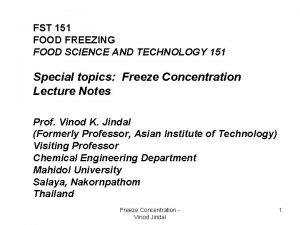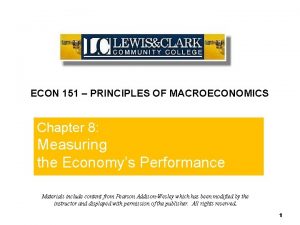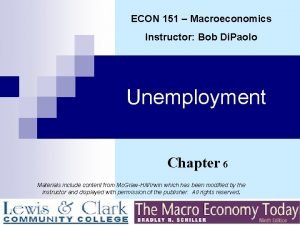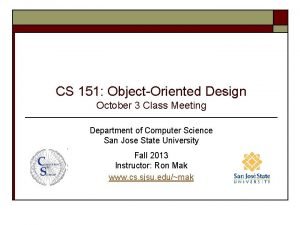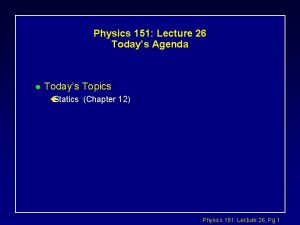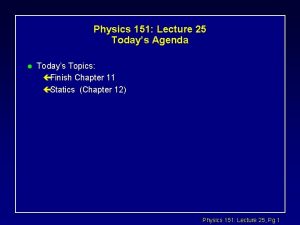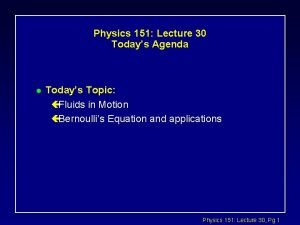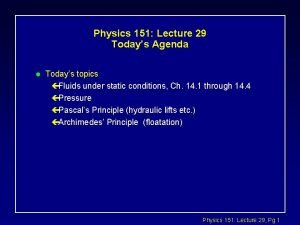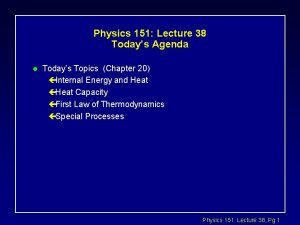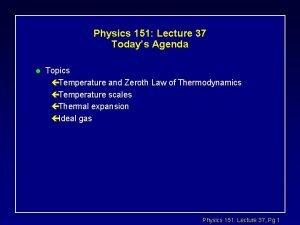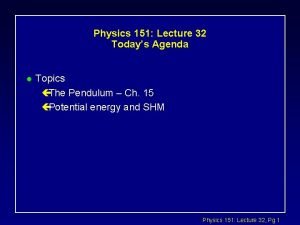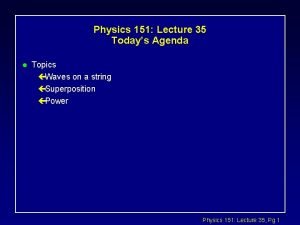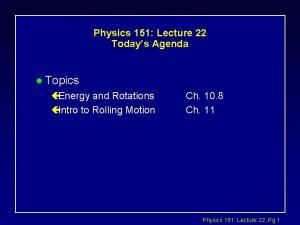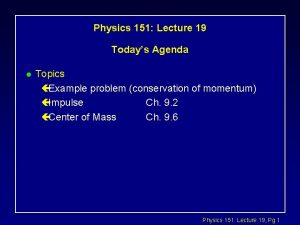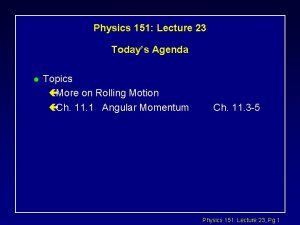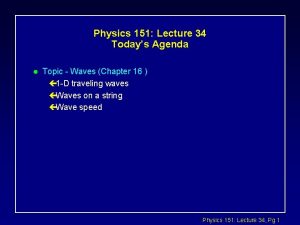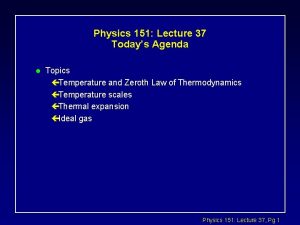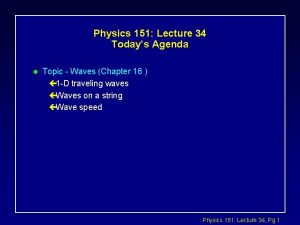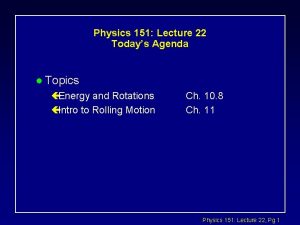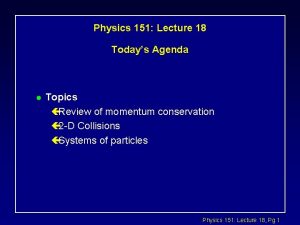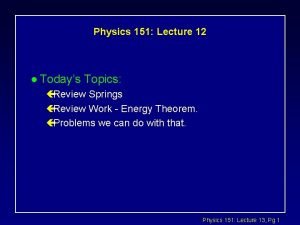Physics 151 Lecture 17 Todays Agenda l Todays




















- Slides: 20

Physics 151: Lecture 17 Today’s Agenda l Today’s Topics : çMomentum (Chapter 9) çConservation of Momentum çIntroduce Collisions (Elastic and Inelastic) Physics 151: Lecture 17, Pg 1

ACT- 2 l Objects A and B, of mass M and 2 M respectively, are each pushed a distance d straight up an inclined plane by a force F parallel to the plane. The coefficient of kinetic friction between each mass and the plane has the same value. At the highest point, 1. 2. 3. 4. 5. KA>KB. KA=KB. KA<KB. The work done by F on A is greater than the work done on B. The work done by F on A is less than the work done on B. Physics 151: Lecture 17, Pg 2

Lecture 16, Example Skateboard l . . Let’s suppose that the surface is not frictionless and the same skateboarder reach the speed of 7. 0 m/s at bottom of the hill. What was the work done by friction on the skateboarder ? Conservation of W + K + U = K + U 1 1 2 2 f Total Energy : m = 25 kg Wf + 0 + mg. R = 1/2 mv 2 + 0 Wf = 1/2 mv 2 - mg. R R=3 m. . Wf = (1/2 x 25 kg x (7. 0 m/s 2)2 - 25 kg x 10 m/s 2 3 m) Wf = 613 - 735 J = - 122 J Total mechanical energy decreased by 122 J ! Physics 151: Lecture 17, Pg 3

Chapter 9 Linear Momentum l Definition: For a single particle, the momentum p is defined as: (p is a vector since v is a p = mv vector). So px = mvx etc. l Newton’s 2 nd Law: F = ma dv l v p Units of linear momentum are kg m/s. Physics 151: Lecture 17, Pg 4

Momentum Conservation l l l The concept of momentum conservation is one of the most fundamental principles in physics. This is a component (vector) equation. çWe can apply it to any direction in which there is no external force applied. You will see that we often have momentum conservation even when (mechanical) energy is not conserved. Physics 151: Lecture 17, Pg 5

Elastic vs. Inelastic Collisions l A collision is said to be elastic when energy as well as momentum is conserved before and after the collision. Kbefore = Kafter çCarts colliding with a spring in between, billiard balls, etc. vi l A collision is said to be inelastic when energy is not conserved before and after the collision, but momentum is conserved. Kbefore Kafter çCar crashes, collisions where objects stick together, etc. Physics 151: Lecture 17, Pg 6

Lecture 17, ACT 1 Collision in 1 -D Winter in Storrs ice (no friction) Physics 151: Lecture 17, Pg 7

M = 2 m Lecture 17, ACT 1 Collision in 1 -D m initially ice (no friction) v=0 V 0 finally vf = ? Vf = A) 0 B) Vo/2 C) 2 Vo/3 D) 3 Vo/2 E) 2 Vo Physics 151: Lecture 17, Pg 8

Lecture 17, Review problem: numerical l High-speed stroboscopic photographs show that the head of a golf club of mass 200 grams is traveling at 55 m/s just before it strikes a 46 -gram golf ball at rest on a tee. After the collision, the clubhead travels (in the same direction) at 40 m/s. Find the speed of the golf ball just after Physics 151: Lecture 17, Pg 9

Inelastic collision in 1 -D: Example 1 l A block of mass M is initially at rest on a frictionless horizontal surface. A bullet of mass m is fired at the block with a muzzle velocity (speed) v. The bullet lodges in the block, and the block ends up with a speed V. In terms of m, M, and V : çWhat is the initial speed of the bullet v ? çWhat is the initial energy of the system ? çWhat is the final energy of the system ? çIs energy conserved ? x v V before See example 12 -6 after Physics 151: Lecture 17, Pg 10

Lecture 19, ACT 2 Let’s do some rocket engineering ! l A rocket engine consumes 450 kg of fuel per minute. If the exhaust speed of the ejected fuel is 5. 2 km/s, what is the thrust of the rocket ? » a. » b. » c. » d. 48 k. N 39 k. N 55 k. N 32 k. N initial final vg M+m v M v+Dv m Physics 151: Lecture 17, Pg 11

Lecture 17, ACT 3 Momentum Conservation l l Two balls of equal mass are thrown horizontally with the same initial velocity. They hit identical stationary boxes resting on a frictionless horizontal surface. The ball hitting box 1 bounces back, while the ball hitting box 2 gets stuck. çWhich box ends up moving fastest ? (a) Box 1 1 (b) Box 2 (c) same 2 Physics 151: Lecture 17, Pg 12

Lecture 17 Review problem: more involved l A 3. 0 -kg mass is sliding on a horizontal frictionless surface with a speed of 3. 0 m/s when it collides with a 1. 0 -kg mass initially at rest as shown in the figure. The masses stick together and slide up a frictionless circular track of radius 0. 40 m. To what maximum height, h, above the horizontal surface will the masses slide? Physics 151: Lecture 17, Pg 13

Lecture 17 Ballistic Pendulum Physics 151: Lecture 17, Pg 14

Lecture 17 ACT 4 The law of conservation of momentum applies to a collision between two bodies if: a. they exert forces on each other respectively proportional to their masses. b. they exert forces on each other respectively proportional to their velocities. d. their accelerations are proportional to their masses. e. they exert equal and opposite forces on each other. Physics 151: Lecture 17, Pg 15

Inelastic collision in 2 -D l Consider a collision in 2 -D (cars crashing at a slippery intersection. . . no friction). V v 1 m 1 + m 2 m 1 m 2 v 2 before after Physics 151: Lecture 17, Pg 16

Inelastic collision in 2 -D. . . l There are no net external forces acting. ç Use momentum conservation for both components. v 1 V = (Vx, Vy) m 1 + m 2 m 1 m 2 v 2 Physics 151: Lecture 17, Pg 17

Inelastic collision in 2 -D. . . l So we know all about the motion after the collision ! V = (Vx, Vy) Vy Vx P P p 1 p 2 p 1 Physics 151: Lecture 17, Pg 18

Comment on Energy Conservation l We have seen that the total kinetic energy of a system undergoing an inelastic collision is not conserved. çEnergy is lost: » Heat » Bending of metal (crashing cars) l Kinetic energy is not conserved since work is done during the collision ! l Momentum along a certain direction is conserved when there are no external forces acting in this direction. çIn general, easier to satisfy than energy conservation. Physics 151: Lecture 17, Pg 19

Recap of today’s lecture l Momentum and Collisions Ch. 9. 1 -9. 4 (part of 9. 4) Physics 151: Lecture 17, Pg 20
 Todays agenda
Todays agenda 01:640:244 lecture notes - lecture 15: plat, idah, farad
01:640:244 lecture notes - lecture 15: plat, idah, farad Agenda sistemica y agenda institucional
Agenda sistemica y agenda institucional Determinants of consumption
Determinants of consumption 118/151
118/151 Cs 151 sjsu
Cs 151 sjsu Alan ableson queens
Alan ableson queens Hino 151
Hino 151 Dpr 151/2011
Dpr 151/2011 Uci cs specialization
Uci cs specialization Rounding off 100
Rounding off 100 Freeze concentration
Freeze concentration 1,151,725 bytes
1,151,725 bytes Econ 151
Econ 151 Econ 151
Econ 151 Tổng kết vốn từ 151
Tổng kết vốn từ 151 Chm 151 final exam
Chm 151 final exam Mcb 151 uiuc
Mcb 151 uiuc Csc
Csc Sjsu cs 151
Sjsu cs 151 Item 151
Item 151
